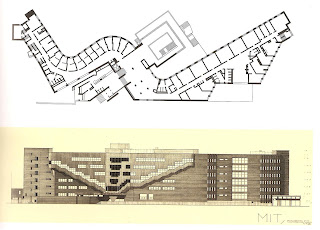Non-critical Regionalism?
During our discussions of Critical Regionalism and Scarcity, I was struck by one of Franco's statements. That Critical Regionalism can only be made, or at least is only most theoretically pure, when it is on the periphery, located away from the hubs of of culture, economy, etc.
This idea has stuck with me because I hope its not true. I think the reason we may not have talked as much during lectures on critical regionalism is because it aligns so much with what our generation has been taught in the past few years of architecture school. Look at local building techniques, be sensitive to user needs and customs, know the environment of the site, be open to the simplicity of a solution, etc. All of these things can, and have been been utilized both in the periphery and the cores of society.
In which case, are projects done in urban centers just not edgy enough to be considered critical regionalism? Can building techniques and forms that used to identify a city (like the Chicago style window, Charleston single-house, or the wrought iron railings of New Orleans) really become too mainstream to be regional? Or is it simply not endangered or unheard of enough to be critical?
A non-critical regionalism.
This idea has stuck with me because I hope its not true. I think the reason we may not have talked as much during lectures on critical regionalism is because it aligns so much with what our generation has been taught in the past few years of architecture school. Look at local building techniques, be sensitive to user needs and customs, know the environment of the site, be open to the simplicity of a solution, etc. All of these things can, and have been been utilized both in the periphery and the cores of society.
In which case, are projects done in urban centers just not edgy enough to be considered critical regionalism? Can building techniques and forms that used to identify a city (like the Chicago style window, Charleston single-house, or the wrought iron railings of New Orleans) really become too mainstream to be regional? Or is it simply not endangered or unheard of enough to be critical?
A non-critical regionalism.
Aalto's Baker House in Cambridge, Massachusetts
Curving towards the river, angled towards the campus
Chicago Style windows in an
early Chicago skyscraper




Good point Russell! I also thought about it but honestly didn't have enough words to phrase it haha. I agree with you because I see a lot of "critical regionalism" within the city of Austin, San Antonio and others that have that "local" style and not only at the periphery. Also, in some parts of Mexico City and even Veracruz but why are they not considered as such? or are they and we are just not paying enough attention to call them that? It is a great question!
ReplyDeleteGreat post, I remember talking to alex on the way back after class about it. Thinking "so...there can only be critical regionalism projects in the woods in the midwest?" haha What would a critical regionalist project in a dense urban environment look like and who decides whether it is or not? Would the urban residents scowl at such design?
ReplyDelete